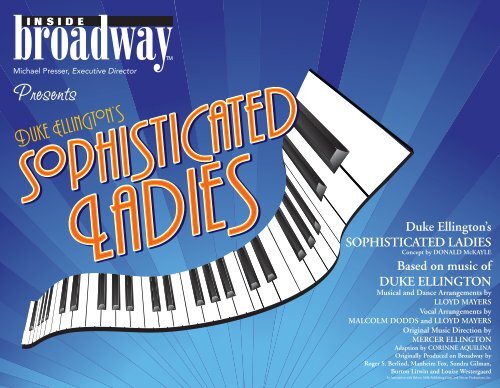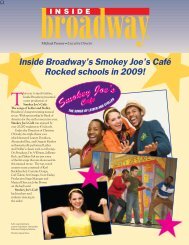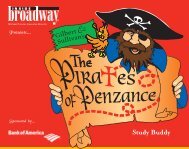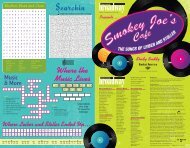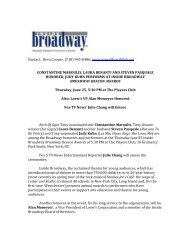Duke Ellington, Sophisticated Ladies - Inside Broadway
Duke Ellington, Sophisticated Ladies - Inside Broadway
Duke Ellington, Sophisticated Ladies - Inside Broadway
You also want an ePaper? Increase the reach of your titles
YUMPU automatically turns print PDFs into web optimized ePapers that Google loves.
Michael Presser, Executive Director<br />
Presents<br />
<strong>Duke</strong> <strong>Ellington</strong>'s<br />
<strong>Sophisticated</strong><br />
<strong>Ladies</strong><br />
<strong>Duke</strong> <strong>Ellington</strong>’s<br />
SOPHISTICATED LADIES<br />
Concept by DONALD McKAYLE<br />
Based on music of<br />
DUKE ELLINGTON<br />
Musical and Dance Arrangements by<br />
LLOYD MAYERS<br />
Vocal Arrangements by<br />
MALCOLM DODDS and LLOYD MAYERS<br />
Original Music Direction by<br />
MERCER ELLINGTON<br />
Adaption by CORINNE AQUILINA<br />
Originally Produced on <strong>Broadway</strong> by<br />
Roger S. Berlind, Manheim Fox, Sondra Gilman,<br />
Burton Litwin and Louise Westergaard<br />
In Association with Belwin Mills Publishing Corp. and Norzar Productions, Inc.
Michael Presser, Executive Director<br />
Board of Directors<br />
Irwin Fingerit,<br />
Chairman<br />
Michael Presser<br />
President<br />
Howard Zipser,<br />
Vice President<br />
Elliot Altman,<br />
Treasurer<br />
William Tung,<br />
Secretary<br />
Richard Basini<br />
David I. Cohen<br />
Joseph V. Cozza<br />
John Diaz<br />
Anthony W. Guido<br />
Eric Gural<br />
Mark Irgang<br />
Mary Landolfi<br />
Alan Momeyer<br />
George Stonbely<br />
Honorary Members<br />
Barbara J. Fife<br />
Mrs. Bernard B. Jacobs<br />
James L. Nederlander<br />
Vicki Singer<br />
Teaching Artists<br />
Clark Ausloos<br />
Jen Faith Brown<br />
Michael Flanagan<br />
BJ Gandolfo<br />
Camille Gaston<br />
Dan Gordon<br />
Samantha Hancock<br />
Adam Hose<br />
Angela Jamieson<br />
Abigail Jones<br />
Mark Lingenfelter<br />
Braddon Mehrten<br />
Evan Paquette<br />
Kerry Prep<br />
Wende Pollack<br />
Ethan Schlesser<br />
Shay Saint Victor<br />
Ethan Wagner<br />
Britton Williams<br />
Worth Williams<br />
Advisory Board<br />
Carol Channing,<br />
Honorary Chair<br />
Mary Ellin Barrett<br />
Laura Benanti<br />
Theodore S. Chapin<br />
Kristin Chenoweth<br />
Barbara Cook<br />
Tovah Feldshuh<br />
Sutton Foster<br />
Joel Gray<br />
Nathan Lane<br />
Paul Libin<br />
630 Ninth Avenue, Suite 802<br />
New York, NY 10036<br />
Telephone: 212-245-0710<br />
Fax: 212-245-3018<br />
www.insidebroadway.org<br />
Administrative Staff<br />
Michael Presser,<br />
Executive Director<br />
Nicholas M. Sala,<br />
Company Manager<br />
Katie McAllister,<br />
Program Director<br />
Abigail Jones,<br />
Controller<br />
Laura Jean Hawkins,<br />
Government Relations<br />
The Dryfoos Group<br />
David Jaffe,<br />
Marketing & Events<br />
Jaffe Management, Inc<br />
Melissa Fisher,<br />
Development Consultant<br />
Reva Cooper,<br />
Publicity<br />
Jeremy Howowitz,<br />
Web Design<br />
Pia Lindstrom<br />
Rebecca Luker<br />
Peter L. Malkin<br />
Constantine Maroulis<br />
Karen Mason<br />
Donna Murphy<br />
Bebe Neuwirth<br />
Fred Papert<br />
Steven Pasquale<br />
Faith Prince<br />
Susan Stroman<br />
Karen Ziemba<br />
Our Mission:<br />
<strong>Inside</strong> <strong>Broadway</strong> is a professional New York City based children’s theatre company committed<br />
to producing <strong>Broadway</strong>’s classic musicals in a contemporary light for young audiences.<br />
Our Supporters:<br />
The New York City Department of Education; New York State Office of Children and Family<br />
Services; New York City Department of Cultural Affairs; New York City Department of Youth<br />
and Community Development; New York City Department for the Aging; New York State Office<br />
of Parks Recreation and Historic Preservation and New York State Department of Education.<br />
New York City Council; Christine Quinn, Speaker, Domenic Recchia, Chair Cultural Affairs<br />
Committee and Council Members Joseph Addabbo, Jr., Tony Avella, Anthony Como, Erik<br />
Martin Dilan, Lew Fidler, Daniel Garodnick, Eric Gioia, Vincent Gentile, Sara Gonzalez,<br />
Vincent Ignizio, Melinda Katz, Michael McMahon, Annabel Palma, Joel Rivera, Larry<br />
Seabrook, Helen Sears, James Vacca and Thomas White, Jr.<br />
New York State Assembly Members Peter Abbate, Michael Benedetto, Jonathan L. Bing,<br />
Barbara M. Clark, Vivian E. Cook, Adriano Espaillat, Michael Gianaris, Richard Gottfried,<br />
Rhoda S. Jacobs, Brian Kavanagh, Felix W. Ortiz, Michele Titus, Mark Weprin and Ellen Young<br />
New York State Senators Andrew Lanza, John Flanagan, George Onorato and Tom Duane<br />
These programs are supported in part, by public funds from<br />
the New York City Department of Cultural Affairs.<br />
<strong>Inside</strong> <strong>Broadway</strong>’s foundation supporters includes: The BMI Foundation Inc.; Con Edison;<br />
Jewish Communal Fund; Joan and Alan Ades – Taub Family Foundation; Loews Foundation;<br />
New York Community Trust; The DuBose and Dorothy Heyward Memorial Fund; The Selz<br />
Foundation, Inc.; The Shubert Foundation; The Town Hall Foundation and The Victor E.<br />
Perley Fund<br />
<strong>Inside</strong> <strong>Broadway</strong> also receives support from the following corporations: Akerman<br />
Senterfitt LLP; Associated Musicians of Greater New York, Local 802, AFM; Bank of America;<br />
Capital Moving and Storage; Cipriani USA; Canon Business Solutions; Fry Wagner Moving<br />
and Storage; Hospitality Careers Online, Inc; Heidrick& Struggles; International Coffee<br />
Systems; Jaffe Management; Local One IATSE; Loews Corporation, Newport Painting;<br />
Office Supply WHSE Corp; Ogletree Deakins; Proskauer Rose LLP; Prudential; Spectacular<br />
Ventures; Stearns Weaver Miller; Sterling Information Systems; The New York Marriott<br />
Marquis Hotel; The Rockefeller Group International, Inc.; The Times Square Alliance and<br />
United Health Care<br />
<strong>Inside</strong> <strong>Broadway</strong> also receives support from the following individuals: Sharen Benenson,<br />
Jack Brucculeri, Irwin Fingerit, Barry Goldberg, Gail Gordon, Michael Griffin, Rachel<br />
Hirschfeld, Phuong Ky, Ronald Leven, Peter Malkin, Delmor and Phyllis; Markoff, Martin<br />
McLaughlin, Catherine Michaelson, Alan Momeyer, Michael Royce Laurie Stevens, George<br />
Stonbely, Jonathan Tisch, William Tung, and Howard Zipser<br />
<strong>Inside</strong> <strong>Broadway</strong> is a member of The <strong>Broadway</strong> League, Producers League of Theatre for<br />
Young Audiences, Inc. (PLOTYA);<br />
Alliance of Residence Theatres/New York (A.R.T./ New York); New York City Arts in<br />
Education Roundtable (AIE),<br />
NYC Arts Coalition, The Mayor’s Midtown Citizens Committee and The <strong>Broadway</strong><br />
Association.<br />
©<strong>Inside</strong> <strong>Broadway</strong> 2010 All Rights Reserved..<br />
Study Buddy written by Katie McAllister<br />
Design by Cybill Conklin
Apollo<br />
Uptown<br />
Improvisation<br />
Opportunity<br />
Sugarhill<br />
crisis<br />
Jazz<br />
Savoy<br />
swing<br />
harlem<br />
lennoxavenue<br />
subway<br />
tap<br />
2<br />
1<br />
N<br />
N<br />
H<br />
P<br />
K<br />
S<br />
F<br />
O<br />
R<br />
W<br />
C<br />
Y<br />
E<br />
G<br />
V<br />
3<br />
D<br />
G<br />
O<br />
T<br />
D<br />
I<br />
A<br />
B<br />
U<br />
R<br />
S<br />
O<br />
A<br />
Q<br />
S<br />
X<br />
Z<br />
Y<br />
S<br />
I<br />
T<br />
Z<br />
C<br />
R<br />
U<br />
N<br />
W<br />
B<br />
G<br />
D<br />
4<br />
Road to<br />
E<br />
O<br />
N<br />
A<br />
W<br />
I<br />
T<br />
L<br />
P<br />
A<br />
L<br />
J<br />
P<br />
E<br />
O<br />
U<br />
N<br />
U<br />
V<br />
A<br />
B<br />
L<br />
I<br />
S<br />
E<br />
V<br />
W<br />
K<br />
Y<br />
U<br />
5<br />
Y<br />
A<br />
M<br />
W<br />
J<br />
S<br />
T<br />
M<br />
Y<br />
W<br />
N<br />
I<br />
A<br />
Y<br />
L<br />
6<br />
Harlem<br />
7 8<br />
W<br />
I<br />
H<br />
Z<br />
S<br />
R<br />
I<br />
G<br />
F<br />
D<br />
J<br />
S<br />
X<br />
Q<br />
D<br />
G<br />
V<br />
Z<br />
F<br />
O<br />
A<br />
E<br />
V<br />
T<br />
V<br />
E<br />
T<br />
O<br />
A<br />
F<br />
Q<br />
A<br />
V<br />
P<br />
S<br />
M<br />
C<br />
Y<br />
O<br />
V<br />
Z<br />
M<br />
N<br />
J<br />
D<br />
9<br />
J<br />
P<br />
P<br />
O<br />
L<br />
L<br />
O<br />
P<br />
A<br />
R<br />
H<br />
I<br />
N<br />
N<br />
Z<br />
O<br />
T<br />
O<br />
U<br />
T<br />
E<br />
A<br />
I<br />
P<br />
F<br />
M<br />
A<br />
K<br />
Z<br />
H<br />
Z<br />
W<br />
O<br />
Y<br />
O<br />
P<br />
K<br />
X<br />
M<br />
E<br />
L<br />
J<br />
R<br />
C<br />
L<br />
10<br />
N<br />
B<br />
S<br />
R<br />
B<br />
U<br />
V<br />
K<br />
G<br />
Q<br />
N<br />
A<br />
N<br />
B<br />
R<br />
I<br />
R<br />
H<br />
H<br />
Z<br />
I<br />
Z<br />
S<br />
L<br />
F<br />
B<br />
L<br />
H I S A T E A D I E S S S O P D D L T I C<br />
V<br />
A<br />
S<br />
A<br />
C<br />
U<br />
U<br />
S<br />
N<br />
Who Are We?<br />
I<br />
V<br />
F<br />
X<br />
U<br />
F<br />
O<br />
Q<br />
A<br />
Across<br />
2. where young singers compete<br />
3. famous Jazz musician<br />
5. what the Nicholas Brothers were famous for<br />
6. the period in Harlem from 1918-1929<br />
9. type of suit worn by young men<br />
10. popular swing dance<br />
Down<br />
1. first African American record label<br />
4. variety of African dance steps<br />
7. Douglas famous African American painter<br />
8. home of Jazz
We Now Present…<br />
E<br />
N<br />
A<br />
I<br />
A<br />
E<br />
5,6,7,8 – Dance!<br />
H E<br />
C C U B<br />
H E E U G R O<br />
T C H D N O T A<br />
R A L D L K I S N A<br />
O E L N I S T T T O N T<br />
Step Back in Time<br />
A B C D E F G H I J K L M N O P Q R S T U V W X Y Z<br />
E E E E<br />
1 19 15 19 10 7 3 15 14 7 15 23 10 16 18 18 10 23 12 15
<strong>Sophisticated</strong> <strong>Ladies</strong><br />
On <strong>Broadway</strong><br />
A collection of songs by <strong>Duke</strong> <strong>Ellington</strong>, <strong>Sophisticated</strong> <strong>Ladies</strong><br />
opened on <strong>Broadway</strong> at the Lunt-Fontaine Theatre on March 1,<br />
1981.. The production which starred Gregory Hines, won 2 Tony<br />
awards and ran had 767 performances. <strong>Sophisticated</strong> <strong>Ladies</strong><br />
was not a traditional “book” musical, it was a “musical revue”<br />
which simply meant that it had only singing and dancing and no<br />
storyline. The show used tap, swing and jazz dance to help tell<br />
the “story” through song. Some of the songs in the show were;<br />
“It Don’t Mean a Thing (If It Ain’t Got That Swing)”, “Hit Me<br />
With a Hot Note and Watch Me Bounce”, “Take the A Train”,<br />
“Don’t Get Around Much Anymore”, “I’m Beginning to See the<br />
Light” and “Satin Doll”.<br />
Jazz Hot<br />
What exactly is Jazz and where<br />
did it come from?<br />
An original American artform, Jazz music was created in New Orleans around the turn<br />
of the century by African Americans with its roots based in ragtime, blues and spirituals.<br />
The cornerstone of Jazz is improvisation which lets the musician “make up” their own<br />
notes and rhythms so that the music sounds spontaneous and new. While Jazz started<br />
around the turn of the 20th Century, its popularity reached its height in the 1920’s and<br />
30’s as the Great Depression plunged many into economic hard times. While people<br />
could not afford to go to clubs and shows, they could listen to the radio at home for<br />
free. Jazz not only survives these decades, it flourished and became even more popular<br />
with the public. As Jazz music spreads across the country, it changed slightly from region<br />
to region, from the urban sound of Chicago Jazz, to the loose, spontaneous swing of<br />
Kansas City Jazz. Even with all of the different “improvisations”, Jazz becomes a recognized<br />
style that is still changing and thriving today.<br />
To Learn More About…<br />
Black<br />
Swan<br />
Records<br />
Founded by Harry Herbert Pace in 1921, Black Swan Records<br />
became the first African American owned recording company<br />
in the United States. The company’s first office was located at<br />
257 West 138th Street, which also happened to be Harry Pace’s<br />
home. The name “Black Swan Records” was chosen to honor<br />
the accomplishments of Elizabeth Taylor Greenfield, a talented<br />
African American singer know as “The Black Swan”.<br />
With the signing of a young singer by the name of Ethel Waters,<br />
Pace turned the record label into a success that led to the<br />
purchase of a building on 135th Street and Seventh Avenue that<br />
employed 30 people in its offices and shipping rooms. By this<br />
time, Black Swan had expanded its recording and selling of music<br />
to various genres including opera and symphony orchestras.<br />
In 1922, Black Swan Records found it increasingly hard to sign<br />
Black artists for its roster as record labels such as Columbia, Okeh<br />
and Paramount began to see the benefit in producing Jazz and<br />
Blues records and began to pursue these artists. Around this time<br />
the popularity of radio broadcasts came about which hurt record<br />
sales around the country.<br />
In December of 1923, Black Swan Records declared bankruptcy<br />
and in 1924, leased the song catalog to Paramount Records.<br />
The Harlem Renaissance visit www.jcu.edu/harlem/index.htm<br />
Tap Dancing visit http://atdf.org<br />
Jazz Music visit http://www.pbs.org/jazz<br />
The New York City Transit System visit http://www.nycsubway.org
The Cotton Club<br />
Opened in 1920 under the name Club Deluxe, it changed<br />
owners in 1922 and was renamed The Cotton Club. Located<br />
on 142nd Street and Lennox Avenue, it hosted some of<br />
the best entertainment of the day including <strong>Duke</strong> <strong>Ellington</strong><br />
and his orchestra, who became the house band in 1927. Some other notable performers of<br />
the day included Bill “Bojangles” Robinson, Louis Armstrong, Ethel Waters and the Nicholas<br />
Brothers. While the performers at the Cotton Club were of African American descent the club<br />
was segregated and admitted only white patrons. The Cotton Club enjoyed immense success<br />
from 1922 to 1936 at its Harlem location and then moved downtown to West 48th Street<br />
where it stayed until 1940. You can still visit the Cotton Club at its current location on 125th<br />
Street in Harlem or watch a recreation of it on film Francis Ford Coppola’s “The Cotton Club”<br />
Stompin<br />
at the<br />
Savoy<br />
During the 1920’s and 30’s, Harlem’s Savoy Ballroom was the place to<br />
go for dancing. Located on Lenox Avenue between 140th and 141st<br />
streets the Savoy was known downtown as the “Home of Happy Feet”<br />
while in Harlem is was simply known as “The Track”. Unlike the Cotton<br />
Club, the Savoy was an integrated club where both white and black<br />
dancers shared the floor. When you came to the Savoy, the color<br />
of your skin didn’t matter, what people really wanted to know was<br />
“Can you dance?” The Savoy was the hot spot for dance from the<br />
day it opened on March 12th 1926 until it closed on July 10th 1958.<br />
A plaque was placed on the site of the original ballroom in 2006.<br />
It’s Showtime…<br />
At the Apollo<br />
Known as the place “Where Stars are Born and Legends<br />
are Made”, the Apollo Theatre was built in 1914 and was<br />
originally called the Hurtig and Seamon Theatre. In 1934,<br />
Ralph Cooper decided to do a live version of his popular<br />
radio show “Amateur Hour at the Apollo” at the Apollo<br />
Theatre. Singer Ella Fitzgerald was one of the first winners.<br />
In 1935 Bessie Smith made her first appearance at the<br />
Apollo as did a young singer by the name of Billie Holiday.<br />
The Apollo quickly became a launching pad for many groups<br />
and performers including The Jackson Five, Stevie Wonder,<br />
James Brown and Lauryn Hill. Today, the Apollo is still<br />
going strong with its “Showtime at the Apollo” talent show<br />
and hosting major performers<br />
from around the world.<br />
Suit Yourself<br />
Toward the end of 1930’s, zoot suits began to make their way onto the scene.<br />
In the urban Jazz culture of Harlem, the word “zoot” meant something<br />
exaggerated, either in style, sound or performance. Zoot suits were favored<br />
by young men who liked an extravagant way of dressing and considered<br />
themselves “hip cats”. The suit was for having fun, with baggy pants for<br />
dancing, and a long coat and wide brimmed hat to make the wearer look<br />
“grown up”. When <strong>Duke</strong> <strong>Ellington</strong> performed the song “Jump for Joy” at<br />
the Orpheum Theatre in Los Angeles in 1941, all of the performers wore zoot<br />
suits. However, the musician most identified with the zoot suit is fellow jazz<br />
great Cab Calloway. Today we see similar trends in style with young men<br />
wearing baggy pants and shirts as a way to express themselves.<br />
Take the A Train<br />
A TRAIN
<strong>Duke</strong> <strong>Ellington</strong><br />
1899-1974<br />
<strong>Duke</strong> <strong>Ellington</strong> is considered one of America’s greatest<br />
composers. Born Edward Kennedy <strong>Ellington</strong> on April<br />
29, 1899 in Washington D.C., <strong>Duke</strong>’s involvement with<br />
music didn’t start until his teens. At the age of fourteen, <strong>Ellington</strong> went to Asbury<br />
Park, NJ to work as a dishwasher at a summer resort where he heard his first ragtime<br />
composition. The music set off a light in <strong>Duke</strong> and he began to pursue music with a<br />
passion. After playing with bands in Washington D.C. and teaching himself piano by<br />
watching and imitating other players, he became a professional musician by the age<br />
of 16 and began to see the changes that he could make jazz music to create his own<br />
style. In 1923, <strong>Duke</strong> received a job offer in New York City from band leader Wilbur<br />
Sweatman. <strong>Ellington</strong> moved to Harlem during an era known as the Harlem Renaissance,<br />
a French word meaning “rebirth”. He made his mark in Harlem as he and his<br />
band became regulars at nightclubs such as the Savoy Ballroom and Cotton Club.<br />
After leaving the Cotton Club in 1931, <strong>Ellington</strong> capitalized on his fame by touring<br />
the United States and England. Toward the end of his life, <strong>Duke</strong> <strong>Ellington</strong> received<br />
many honors, awards and honorary degrees in celebration of his music.<br />
Ethel Waters<br />
1896 – 1977<br />
Growing up in poverty in Chester, Pennsylvania, Ethel<br />
Waters became one of the most successful and highly paid<br />
entertainers of the early 20th century. The singer’s career<br />
began in 1911, where at the age of 15 she sang at a local<br />
Halloween party and wowed the crowd with her voice. Ethel<br />
found steady work as a singer and dancer on the vaudeville circuit with the<br />
nickname “Sweet Mama Stringbean”. In 1919, Waters moved to Harlem<br />
where she became the first artist to record for Black Swan Records in 1921.<br />
Her recordings of “Down Home Blues” and “Oh Daddy” became overnight<br />
hits and helped to make her a national star. Ethel sang at Carnegie Hall and<br />
headlined at the famed Cotton Club with <strong>Duke</strong> <strong>Ellington</strong> where she introduced<br />
her trademark song “Stormy Weather”, she also appeared on <strong>Broadway</strong><br />
in “Blackbirds” and “As Thousands Cheer” as well as several other<br />
revues. In 1929, she made her film debut in “On with the Show” and later<br />
appeared in “Check and Double Check”. In 1949, Ethel was nominated<br />
for an Academy Award for her performance in “Pinky”, a controversial film<br />
about American race relations. She received her 2nd nomination in 1950 for<br />
her performance in “The Member of the Wedding” based on the book by<br />
Carson McCullers. Ethel Waters died in<br />
Los Angeles in 1977 at the age of 81.<br />
Aaron Douglas<br />
1899- 1979<br />
Considered the father<br />
of African American Art,<br />
Aaron Douglas was born<br />
in Topeka, Kansas in<br />
1899. Like many young<br />
African American men,<br />
Douglas came north<br />
during the Great Migration at the turn of<br />
the 20th century in search of a better life.<br />
In 1922, he received a Bachelor of Fine Arts<br />
degree from the University of Nebraska and<br />
began teaching in Kansas City. In 1925, he<br />
moved to Harlem, which was quickly becoming<br />
the center of a new movement toward<br />
African American cultural pride and identity.<br />
In Harlem he found great success, he was<br />
published in many magazines and books<br />
and was commissioned to create murals for<br />
the Countee Cullen Library as well as Fisk<br />
University.<br />
Douglas was the first artist to depict African<br />
Americans as proud, strong people with a<br />
rich African heritage in his artwork and to explore<br />
African art with contemporary themes.<br />
Emphasizing the need for a solid education,<br />
he continued to study and create art<br />
throughout his lifetime and in 1940 began to<br />
teach art at Fisk University where he eventually<br />
became Chair of the Art Department.<br />
The Harlem Renaissance<br />
Countee Cullen<br />
1903- 1946<br />
Born in Louisville, Kentucky, Poet<br />
Countee Cullen moved to New York<br />
City with his grandmother as a small<br />
child. After her death, he was adopted<br />
by Harlem minister Reverend Frederick<br />
A. Cullen and his wife Carolyn.<br />
Cullen, who became the most popular<br />
African American poet in America,<br />
began writing poetry in high school<br />
where he won his first literary contest<br />
with the poem “I Have a Rendezvous<br />
with Life”. After graduating from Harvard<br />
in 1927, he was frequently published<br />
in “Opportunity” and “Crisis”<br />
magazines where much of his poetry<br />
spoke of the strength and resolve of<br />
African American creativity and intellect<br />
in the face of racial discrimination<br />
as well as a feeling of alienation in<br />
his homeland. Countee Cullen died<br />
at the age of 43 in 1946. To honor his<br />
contribution to the Harlem Renaissance,<br />
a branch<br />
of the New York<br />
City Library<br />
was named The<br />
Countee Cullen<br />
Regional Library<br />
in 1951.<br />
By the end of the 1920’s, Harlem had become the center of African American culture in the<br />
United States. Looking for the better life that the northern urban cities promised due to the<br />
boom in the industrial jobs and the flourishing economy following World War I, many African<br />
Americans migrated from the south in search of good jobs. Harlem was originally called Nieuw<br />
Haarlem by Peter Stuyvesant, the last Dutch governor of New York when it was established<br />
in 1658. In the early 1900’s, with vacancy in apartments on the rise, and landlords looking<br />
for tenants who could pay rent, a young realtor by the name of Philip A. Payton saw this as a<br />
great opportunity to fill those apartments with African Americans. Soon Harlem became the<br />
largest Black community in the world and the new arrivals brought with them their culture,<br />
music and art. From 1918 to the 1929, the extraordinary number of artists, writers and musicians<br />
living in Harlem gave birth to a time in history called “The Harlem Renaissance”.
Read All About It<br />
During the Harlem Renaissance, there<br />
were two important magazines providing<br />
an outlet for art and literature.<br />
Opportunity, published by the National<br />
Urban League and Crisis a monthly<br />
periodical published by the NAACP,<br />
were dedicated to African American<br />
issues, art and literature. Through their<br />
literary contests they were able to give voice to several<br />
important writers of the day including Countee Cullen and Nora<br />
Zeale Hurston along with publishing the artwork of Aaron<br />
Douglas. Many publishing companies looked to these magazines<br />
to find young Black writers with new<br />
ideas and perspectives which led to<br />
a wider audience.<br />
It Don’t Mean a Thing<br />
if it Ain’t Got That Swing…<br />
The history of swing dancing dates back to the<br />
early 1920’s. During this time dancers discovered the<br />
Charleston and Lindy Hop while dancing to Jazz music.<br />
By the 1930’s the Jitterbug had joined these dances to<br />
form the basis of swing dancing as we know it today.<br />
Swing dancing was a hit with the people, but not with<br />
dance teachers. Dance schools such as The New York<br />
Society of Teachers an Arthur Murray did not begin<br />
teaching these dances until the early 1940’s.<br />
“Take the A Train” is one of <strong>Duke</strong> <strong>Ellington</strong>’s best know<br />
recordings and a great way to get home if you happen to live<br />
uptown. At 31 miles, the “A” train is the longest subway line<br />
in the New York City Transit System and spans from Queens<br />
to Brooklyn to the tip of Manhattan. Opened in 1932, the<br />
“A” was the first subway route operated by New York City as<br />
part of the Independent (IND) subway system and originally<br />
spanned only 12 miles, from Chambers Street in lower Manhattan<br />
to Harlem. As the lyrics state “If you miss the A train,<br />
you’ll find you missed the quickest way to Harlem”.<br />
On Tap<br />
Even though tap dancing has its roots in Irish<br />
step dancing and clogging, it is an original<br />
American art form. Between the 1600’s and<br />
1800’s tap evolved from European step dances<br />
and a variety of African steps that were labeled<br />
“juba” and “ring shout” dances.<br />
After the Civil War, new steps were added<br />
to the tap vocabulary including “stop time”,<br />
“soft shoe” and “time step”. At the turn of<br />
the 21st century, tap gained prominence in<br />
vaudeville with performers such as Bill “Bojangles”<br />
Robinson and John Bubble and later<br />
in film musicals staring such renowned dancers<br />
as Fred Astaire and the Nicholas Brothers. As<br />
the 1950’s approached, tap began to lose its<br />
popularity as dance styles changed and new<br />
dances were introduced. In the 1960’s several<br />
public tap dance events reignited an interest in<br />
what was now considered an art form. Starting<br />
in the 1980’s, tap reappeared on the <strong>Broadway</strong><br />
stage in such musicals as Jelly’s Last Jam, Black<br />
and Blue, The Tap Dance Kid and 42nd Street.<br />
In 1989, Congress designated May 25th as<br />
“National Tap Dance Day”, which is celebrated<br />
by people across the United States.<br />
Art Deco<br />
During the roaring twenties and the<br />
early thirties, Art Deco architecture<br />
was all the rage. Like many styles it<br />
is a combination of different influences<br />
from many sources. You can<br />
easily see the influence of Egyptian<br />
design in Art Deco style which many<br />
attribute to the discovery of King<br />
Tutankhamen’s tomb by English<br />
Egyptologist Howard Carter in 1922.<br />
Other influences include Roman,<br />
Greek and other Middle Eastern<br />
styles. Jewelry, clothing, artwork and<br />
buildings made during the 1920’s<br />
and 30’s often reflect this unique<br />
style, especially here in New York<br />
City. Many apartment buildings have<br />
crown moldings, arched doorways<br />
and feature “Egyptian” style tile<br />
work and statues on the outside and<br />
entryways. The Empire State Building,<br />
Chrysler Building and Radio<br />
City Music Hall are three of the most<br />
famous examples of Art Deco design<br />
here in the city.


